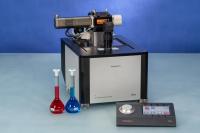Interfacial rheology

Interfacial rheology
With interfacial rheology the viscoelastic behavior and stress relaxation of an interface can be characterized. If there are interfacially active components (surfactants, polymers, nanoparticles...) present, they make this more complex. These compounds adsorb and form a layer at the interface. When the available interfacial area changes, the interfacially active components react to the deflexion out of the equilibrium state.
When the interfacial area is decreased, the interfacial concentration increases, and the system tries to reach its equilibrium by desorbing the active components from the interface. When the interfacial area is increased, the interfacial concentration decreases and the equilibrium state is restored by adsorbing active components.
Since the interfacial concentration of active components changes the interfacial tension between the phases changes accordingly. For example, when the surfactant concentration at the interface increases by decreasing the available area, the interfacial tension will decrease as well. And if the area is being increased, so does the interfacial tension. The reaction by the interfacially active components can occur at different speeds. This can depend on various factors like the mobility of the components inside the bulk phase, the bulk concentration and the interfacial energy between the phases.
The complex viscoelastic modulus can be measured by continuously decreasing and increasing the interfacial area in an oscillatory manner. The phase shift depends on the reaction speed of the interfacially active components. The faster the interfacially active components react by adsorbing and desorbing to the interface, the larger the phase shift becomes.
Related instruments
DataPhysics offers multiple systems that enable the measurement of the viscoelastic modulus. With an optical contact angle measuring and contour analysis system of the OCA product series and corresponding accessories, oscillating pendant drops can be created. Using the SVT 25 spinning drop video tensiometer the rotational velocity of a spinning drop can be oscillated. By using a dynamic contact angle measuring device and tensiometer of the DCAT product series the position of the barriers of a Langmuir through can be oscillated. Once the viscoelastic behaviour has been optimised the influence on the stability of an emulsion can be analysed with the MultiScan MS 20 dispersion stability analysis system.
